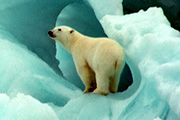Threats
Hunting
The international Agreement on the Conservation of Polar Bears allows for the taking of polar bears for use by local people using traditional methods and exercising traditional rights. WWF supports the right of indigenous peoples to continue to sustainably harvest local animals.
Today, legal hunting of polar bears by non-native sport hunters is only found in Canada. The community itself decides what proportion of the quota it has been issued for subsistence hunting will be used for outside sport hunters.
In the areas that lack regular monitoring of populations and harvest levels, such as Russia and Greenland, little information is available on current hunting practices. Since it is not known whether killing polar bears is balanced against the sustainable yield of a known population size in such areas, there is reason for concern regarding the sustainability of these practices.
Climate change
The Intergovernmental Panel on Climate Change has confirmed that human-induced climate change is a reality. It can no longer be dismissed as a theory. In the Arctic, climate change impacts are being seen earlier and more dramatically than elsewhere in the world.
In the southern range of polar bears, for example in the Hudson and James Bays of Canada, sea ice is now melting earlier in the spring and forming later in the autumn. The time bears have on the ice is shorter making it more difficult for them to store the energy they need to survive the summer.
As the periods without food become longer, the overall body condition of these polar bears declines. This is particularly serious for bears that are pregnant or have cubs, and for the cubs themselves. In Hudson Bay, scientists have found the main cause of death for cubs to be either lack of food or lack of fat on nursing mothers.
Toxic pollution
As a top predator, polar bears are exposed to high levels of pollutants through their food. Persistent organic pollutants (POPs) include a wide range of poisonous substances such as heat resistant chemicals (eg. PCBs), industrial by-products such as dioxins and furans; and pesticides like DDT, dieldrin and lindane.
Although some of these chemicals are no longer widely used, they stay in the environment for many years. The chemicals were transported from the south by wind and water currents. When they hit the colder arctic, the chemicals are deposited on the water and ground, and enter the food chain. As larger animals eat smaller ones, the chemicals become more concentrated, so that the largest animals of all often have the highest load of chemicals in their bodies. Long-range POPs currently represent the most serious pollution-related threat to polar bears.
Bears with high levels of some POPs have low levels of vitamin A, thyroid hormones, and some antibodies. These are important for a wide range of biological functions, such as growth, reproduction, and the ability to fight off diseases.
